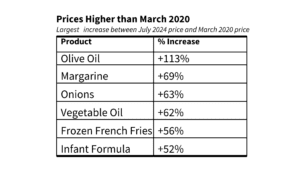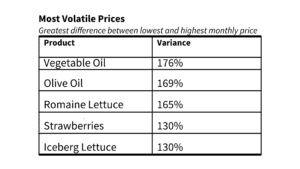Canadian grocery prices have stabilized after four years of tumult. Food inflation has moved lower towards historical norms, but prices are higher than they were before the COVID-19 pandemic.
Statistics Canada tracks monthly average retail prices of 110 grocery store items. Four of those items (laundry detergent, deodorant, toothpaste and shampoo) aren’t food, but may be commonly purchased in grocery stores.
A review of the period from March 2020 – the unofficial start of the COVID-19 pandemic – to July 2024 can determine which products were most volatile, most steady, and showed the greatest increase over that time.
As consumers might expect, almost every price is higher than four years ago. Tomatoes (30% lower) and canned tuna (-13%) are among the few that are lower.
The biggest riser is olive oil, up 113%, followed by margarine. Here’s the top six price increases from July 2024 to March 2020.

Again, these figures are based on national averages tracked by Statistics Canada and standard product quantities. All data is drawn from the Monthly Average Retail Prices for Selected Products table available from Statistics Canada at this link.
Every shopper’s local experiences will vary. The data is calculated monthly. A comparison of those monthly changes can show which product’s prices were the most volatile – the greatest difference between the lowest monthly price and the highest monthly price.

The products with the most stable prices – those with the smallest variation of monthly price – during the period were bananas, followed by meatless burgers and block cheese.
The highest single-month increases were mostly for produce.

The largest monthly price decline was strawberries (-34%) in May 2023, the month immediately following its substantial price jump.
A Consumers Council of Canada’s web panel survey of more than 4,500 grocery shoppers in Canada conducted earlier this year by Environics found those questioned viewed a 15 per cent rise in a grocery item’s price as “an exceptionally high price increase.”
The Statistics Canada data showed that about 45 per cent of products had at least one monthly price increase that consumers would define as exceptionally high over the March 2020 to July 2024 period.
